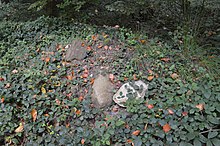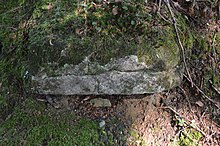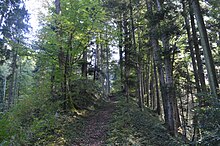Waldburg (Häggenschwil)
| Forest castle | ||
|---|---|---|
| Creation time : | probably around 926 | |
| Castle type : | Hilltop castle | |
| Conservation status: | Burgstall | |
| Place: | Häggenschwil | |
| Geographical location | 47 ° 28 '38.3 " N , 9 ° 20' 47.8" E | |
| Height: | 564 m above sea level M. | |
|
|
||
The forest castle is an abandoned, presumably early medieval Hungarian wall of the St. Gallen Abbey in the eastern part of the municipality of Häggenschwil in the area of the Swiss canton of St. Gallen .
location
The forest castle is located south of the hamlet of Tobel. It was built on a hill around which the Sitter flows from the east, south and west . Until the 20th century there was a stream that flowed past the Waldburg in a northerly direction.
Refuge of St. Gallen Abbey
The forest castle is considered a probable refuge for the St. Gallen Abbey during the Hungarian invasion in 926. The monk Ekkehard IV describes in the Casus Sancti Galli the Hungarian attack on the St. Gallen monastery. The Hungarians were less interested in land acquisition than in booty. At that time the St. Gallen monastery did not yet have a wall, which is why Abbot Englibert sent all old people and young people as well as some monastery brothers to the fortified island of Wasserburg . The abbey library was brought to the island of Reichenau . What remained were those who were fit for military service, as well as the liturgical implements and missal books that were used until recently. It is possible that the monastery archive was moved to the Waldburg. When the Hungarians approached the monastery, the monks withdrew to their refuge. Ekkehard IV's descriptions of the sanctuary of the St. Gallen monks go well with the forest castle, as the following excerpts from the Casus Sancti Galli show:
“However, a place was chosen that was ready for the construction of a castle just as it was offered by God, near the river Sinttriaunum [Sitter]. [...] At the front of the narrowest entrance, the square was fortified with walls and barriers, and a mighty fort was built. "
Most of the area around the Waldburg belonged to the St. Gallen Monastery 1,100 years ago. In 904 the monastery left the villa Liubmanni (a small estate near Lömmenschwil) to a Wolfhere and on the other side of the Sitter there was a farm near what is now Bernhardzell . The proximity to the sitter is given at Waldburg.
"A quickly erected chapel became a house of prayer."
There are no clear remains of a chapel on the Waldburg plateau, but in the center of the Waldburg there is a narrow, rectangular ditch that is filled to the top with larger natural stones and covered with moss. These are probably the remains of a robbery excavation. This stone pit could be a reference to the chapel that once existed, as it was probably built of stone.
“They [the scouts] reported that there was a castle, secured by armed troops, in their immediate neighborhood; then [...] the Hungarians hurried out man by man, and before anyone knew it, they stood, as they were used to, ready to fight in the battle line. "
The Waldburg is about 6.5 kilometers from the monastery district, so it is very close by.
"And after they discovered that they [Wiborada] had found the sacrificial death, they dared no longer line the line and climbed the next mountain, and quickly hitting familiar side paths, they finally got back to the fortress [Waldburg] [... ] "
The mountain mentioned by Ekkehard IV could be the Rosenberg, which lies between the monastery and the forest castle.
history
The sources of the Waldburg for the time after the Hungarian invasion in 926 are very thin. Johannes Rütiger († 1556) reports on the overgrown gates of a former pagan town. Confusion with the nearby ruins of Neu- and Alt-Ramschwag cannot be ruled out. In 1867 August Näf spoke of extensive rubble. A later forest owner described that in the 1890s, one to two meter high walls were removed by the farmers for the construction of stables.
Current situation
The forest castle is located in an archaeological protection zone. Professional archaeological digs have not yet been carried out.
The forest castle is located on a plateau, about 30 meters above the Sitter. The width (W – E) of the Waldburg plateau is 100–125 meters, the length (N – S) 150–160 meters. The inner area amounts to approx. 1.7 hectares. Around the plateau you can still see unnatural heaps of earth.
The land side in the north offers natural protection thanks to a gradient of around 77 percent. Nevertheless, there is an additional embankment of about 0.5 meters along the entire northern slope.
The west side is also protected by an embankment comparable to the north wall and a gradient of up to 71 percent.
The slope of the terrain in the south is a maximum of 10 percent. To compensate for this weak point, there is a rampart about 1.5–2 meters high on the southern foothills of the Waldburg plateau.
The main entrance was presumably in the northwest in the form of an approximately 100 meter long causeway. Towards the top, the entrance is flanked by two embankments that look like platforms. From here, a small neck ditch can still be observed, which arches from the north to the west wall.
Even larger quantities of natural stones can be found distributed over the slopes. This indicates that the forest castle was previously protected by dry stone walls .
literature
- Rafael Wagner: The forest castle near Häggenschwil. A St. Gallen sanctuary in Hungary. In: Writings of the Association for the History of Lake Constance and its Surroundings. 134th issue. Thorbecke, Ostfildern 2016, ISBN 978-3-7995-1722-5 .
- Alexander Thaler: The forest castle. In: History of the community of Häggenschwil. Self-published by the Häggenschwil loan office, Häggenschwil 1972.
Web links
- Waldburg on ortsnames.ch
Individual evidence
- ↑ Ekkehard IV .: St. Galler Klostergeschichten ( Selected Sources on German History of the Middle Ages. Volume X.) Wissenschaftliche Buchgesellschaft, Darmstadt 2013, ISBN 978-3-534-26033-1 , p. 115.
- ↑ Ekkehard IV .: St. Galler Klostergeschichten ( Selected Sources on German History of the Middle Ages. Volume X.) Wissenschaftliche Buchgesellschaft, Darmstadt 2013, ISBN 978-3-534-26033-1 , p. 115.
- ↑ Ekkehard IV .: St. Galler Klostergeschichten (Selected Sources on German History of the Middle Ages. Volume X) Scientific Book Society, Darmstadt 2013, ISBN 978-3-534-26033-1 , p. 121
- ↑ Ekkehard IV .: St. Galler Klostergeschichten ( Selected sources on the German history of the Middle Ages. Volume X.) Wissenschaftliche Buchgesellschaft, Darmstadt 2013, ISBN 978-3-534-26033-1 , p. 123.
- ↑ Alexander Thaler: The forest castle . In: History of the community of Häggenschwil . Self-published by the Häggenschwil loan office, Häggenschwil 1972, p. 25 .
- ^ Rafael Wagner: The forest castle near Häggenschwil. A St. Gallen sanctuary in Hungary . In: Writings of the Association for the History of Lake Constance and its Surroundings . 134th issue. Thorbecke, Ostfildern 2016, ISBN 978-3-7995-1722-5 , pp. 8-9 .



